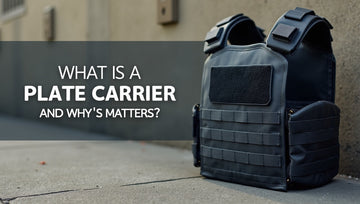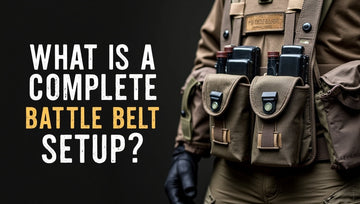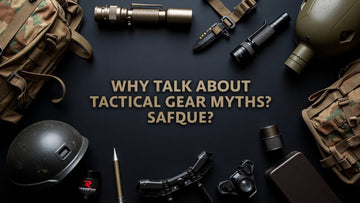“How long does body armor last?” is one of the first questions people ask after investing in protective gear. It’s a fair concern; armor is both expensive and essential. You rely on it in moments when reliability is non-negotiable. The truth is, body armor doesn’t last forever. Its shelf life depends on the material, how it’s worn, and how it’s stored.
At Redemption Tactical, we’ve handled countless vests and plates in every condition imaginable. Over the years, we’ve seen armor that looked fine on the outside but failed ballistic tests because of heat damage, moisture, or poor storage. On the flip side, well-cared-for armor has performed years past its warranty.
Understanding body armor shelf life isn’t just about reading an expiration tag; it’s about knowing how the materials age. The goal of this guide is to help you know exactly how long your armor will stay dependable, how to recognize aging signs, and how to extend its protection as long as possible.
What Determines Body Armor Lifespan?
Several key factors determine body armor lifespan. The first is material. Kevlar, polyethylene, ceramic, and steel all age differently. Kevlar and other aramid fibers weaken as their chemical bonds slowly break down. Polyethylene, used in many lightweight plates, softens under prolonged heat. Ceramic plates lose structural strength when cracked or chipped. Steel, though durable, can corrode if coatings wear away.
The second factor is environment. Heat, moisture, and UV light are the biggest enemies of ballistic protection. Leaving soft armor in a hot car, for instance, can shorten its life. Sweat and humidity accelerate fiber breakdown. Sunlight also weakens outer fabrics over time.
Usage plays its part. Every bend, flex, or impact slowly changes how the armor distributes energy. That’s why daily-use law enforcement vests wear out faster than gear stored for emergencies.
Finally, maintenance and storage habits make a huge difference. Regular inspections, cleaning, and proper handling can add years to your armor’s effective life. Small choices, like keeping it flat and dry, pay off long-term.
Knowing what affects your body armor shelf life helps you control what you can. Most degradation happens slowly, so routine care keeps your protection dependable far longer.
Lifespan of Kevlar, Polyethylene, Ceramic & Steel Armor
Different materials have different shelf lives, and knowing what yours is made from helps you maintain it properly.
Kevlar (Aramid) Armor
Most soft vests use aramid fibers such as Kevlar. These usually have a 5-year warranty, though many remain structurally sound beyond that when stored correctly. The fibers gradually lose strength through exposure to heat, moisture, and sunlight. For active users, five years is a solid replacement benchmark.
Polyethylene (UHMWPE) Armor
This lightweight plastic-based armor resists moisture better than Kevlar but is sensitive to high temperatures. Store it cool and flat. Typical shelf life: about 5–7 years. Avoid prolonged exposure above 150 °F (65 °C).
Ceramic Plates
Ceramic and composite plates stop high-velocity rounds by shattering on impact. Their weakness is brittleness. Even minor drops can cause hidden cracks that compromise performance. The lifespan of ceramic armor usually runs 5–7 years under proper storage, shorter if heavily used.
Steel Plates
Steel armor, if coated and rust-free, can last decades. Technically, steel doesn’t expire. The risk lies in corrosion, denting, or poor coatings that degrade protection. Inspect for rust or deformation regularly.
Overall, these numbers are guidelines, not hard limits. The printed expiration reflects the manufacturer’s tested confidence period, not a sudden cutoff. With good care, the body armor lifespan of most gear extends safely beyond its labeled shelf life.
Warranty vs Real-World Life of Armor
A warranty date and actual usability aren’t the same thing. Manufacturers label armor with an expiration, generally five years, to comply with NIJ standards and liability limits. That date means they guarantee ballistic performance under normal conditions for that period.
In real-world use, the body armor lifespan often continues past that mark, especially if the armor sees limited exposure to heat or sweat. Many collectors and preppers keep vests or plates stored in closets for years without issues.
However, pushing past the warranty means you accept responsibility for ongoing inspection. A vest that’s dry, clean, and intact can still perform, but if the cover, stitching, or panel feels brittle or warped, it’s time to retire it.
Think of the printed date as a maintenance reminder, not an automatic expiration notice. The key question isn’t when the warranty ends, it’s what condition your armor is in today.
Signs It’s Time to Replace Your Armor
Even the best gear shows age. Watch for these clear warning signs:
-
Visible Damage – Fraying edges, cuts, or cracks in plates mean compromised protection.
-
Deformation – Warped or misshapen panels can affect fit and coverage.
-
Soft Spots or Stiff Areas – Changes in flexibility indicate fiber breakdown or moisture damage.
-
Chemical or Water Exposure – Armor exposed to fuel, bleach, or floodwater loses structural integrity.
-
Post-Impact Use – Once armor stops a round, replace it immediately. The ballistic material has done its job and can’t guarantee another stop
Regular checks help you spot these issues before they matter. Feel along seams for rough textures, listen for cracking sounds in ceramic plates, and look for any delamination of layers.
If your body armor shelf life has technically ended, but the gear appears fine, you can still use it for training or display, but not for personal defense.
Storage Tips & Maintenance to Preserve Armor Life
Storage and care directly influence how long body armor lasts. The goal is to prevent heat, moisture, and mechanical stress.
-
Keep It Cool and Dry – Ideal temperature is 60–75 °F (16–24 °C). Avoid garages or car trunks.
-
Store Flat – For soft armor, lay panels flat to prevent creasing. Hard plates can be stored upright in a padded case.
-
Avoid Sunlight – UV rays degrade outer fabrics and ballistic fibers.
-
Don’t Hang by Straps – Over time, this stretches carriers and misshapes panels.
-
Clean Correctly – Remove panels from the carrier before washing. Use mild soap and water by hand; never machine-wash ballistic inserts.
-
Inspect Periodically – Check every few months for fading, odor, or stiffness.
Following these habits extends your armor lifespan beyond its printed date. At Redemption Tactical, we’ve seen well-stored plates still pass ballistic testing years later.
Good storage doesn’t take much effort; it’s about respecting the gear that protects you.
Common Mistakes That Reduce Armor Longevity
A few bad habits shorten body armor shelf life faster than anything else:
-
Leaving it in a hot vehicle – Heat is the number-one killer of ballistic fibers.
-
Folding or rolling panels – Breaks the internal weave.
-
Ignoring moisture – Sweat, rain, or damp carriers accelerate decay.
-
Using harsh chemicals – Bleach or strong cleaners ruin the protective fabric.
-
Neglecting carriers – Damaged carriers twist panels, creating weak spots.
Each of these errors takes years off the gear’s life. Avoiding them means your armor stays trustworthy for as long as the materials allow.
Conclusion
So, how long does body armor last? It depends on materials, environment, and care. Kevlar may last five years, steel decades, but every piece deserves respect and routine inspection.
At Redemption Tactical, we’ve learned that careful storage and regular checks make the difference between armor that fails early and armor that still saves lives years later.
Take a few minutes to inspect your gear today. Clean it, store it right, and replace it when needed. Your safety depends on it, and that’s worth every bit of care you give.
FAQs (Frequently Asked Questions)
Q: Does body armor really expire?
A: Not like food, but materials degrade. The “expiration date” marks when performance can’t be guaranteed.
Q: Can you use armor after its warranty?
A: Yes, if stored properly and in good condition, though it’s best reserved for training once past that date.
Q: How often should you inspect armor?
A: At least twice a year, or after any extreme event such as heavy rain, heat exposure, or impact.
Q: What’s the best storage method?
A: Keep it flat, dry, and away from sunlight or extreme heat.
Q: If you drop a ceramic plate, is it still safe?
A: Probably not. Micro-cracks can form internally. Replace it to stay safe.





